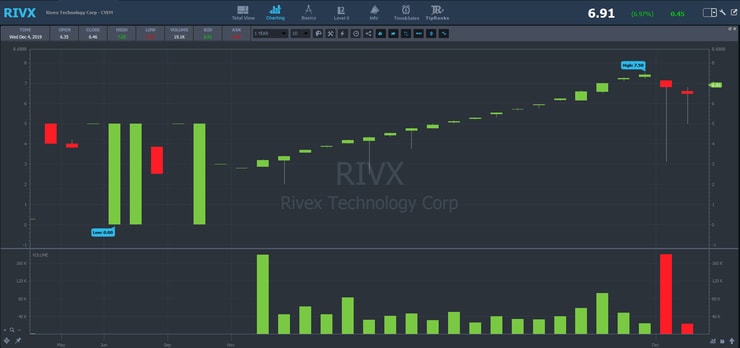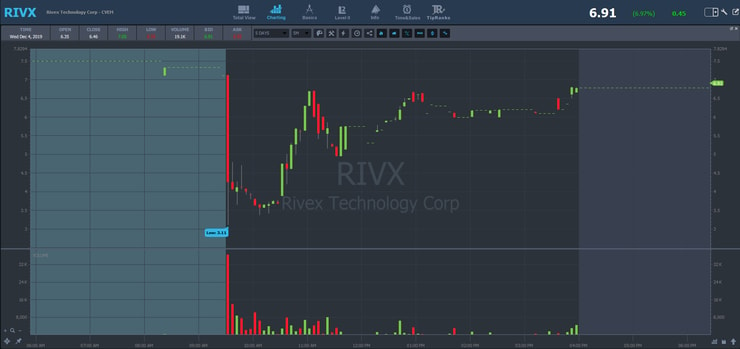Today we’re talking about stock pumps, and how I capitalized on a sketchy stock … it was one of the best morning panic dip buys I’ve seen all year.
There hasn’t been a hot sector in a while, and since the SEC cracked down on pumps, this pattern hasn’t shown up for a couple of months. And many of my students got lazy with their studies…
I’m sad to say … many students weren’t prepared for the perfect bounce on Rivex Technology Corp. (OTC: RIVX).
Table of Contents
Rivex Technology Corp.
If you look at a daily chart of RIVX, it’s clearly a pump. If you’ve never looked at a pump before — burn this chart into your memory.

RIVX originally hit my radar because one of my millionaire mentors, Micheal Goode, posted a report about RIVX on November 7, 2019. In the article, he discussed how the promoters started pumping up the stock price on November 4, 2019, using two websites and email promotions.
Honestly — I don’t care who’s promoting a stock or how. I’m only looking for strong promotions that panic hard in the morning, so I can capture a 20%–50% bounce. This pattern can be very predictable and has often worked well for me.**
Dip buying a pump on its panic day is actually one of my favorite patterns. During the promotion, I never would’ve bought any shares. The current promotion environment is too risky to long pumps. Ten years ago, promoters were awesome! They’d pump stocks like RIVX all the time but bring in substantially more volume.
Today, many of my top students short pumps because they don’t last very long.
The market could really use some better promoters to bring back more high-level plays. But they got greedy. Now the SEC is cracking down on promotions, so I don’t long them until the morning they panic.
Morning Panic Dip Buy
RIVX had been on my watchlist for nearly three weeks by the time it panicked.
I gave students three weeks to prepare for this play, but the morning of the panic … they were still unprepared.
I even had students emailing me using delayed charts and asking why my price was so different from the one they could see. If you’re going to take trading seriously, then you need to use this revolutionary tool. Using the wrong tools can damage your trading career because you’re using old, outdated information. It seriously makes a difference.
Anyway, when the morning panic came … I was ready.

As you can see, RIVX opened at $7.11 and quickly panicked down to $3.11. This is perfect! The larger the panic, the bigger the bounce.
I tried to buy as close to the bottom as possible, but it was kind of illiquid, which made fills difficult. I managed to fill 1,000 shares at $3.81.
For this play, I was only looking for a quick 10%–20% bounce because my entry wasn’t perfect. When it started to bounce small, I got out at $4.31 for a sweet $464 profit.** Check out my verified trade here.
If the volume had been a little better on this play, I would’ve had more confidence to hold longer. I mean look … it bounced over 100% when the Dow was down 200 points! This is why I love penny stocks.

In hindsight, I totally underestimated this bounce — but I understood the pattern and took a single. Rather than swinging for the fences, I locked in the predictable gains, and I’m more prepared for the next stock to morning panic.
Study the Past
The saying “history doesn’t repeat itself, but it often rhymes” is extremely applicable to the stock market.
The market goes through cycles, and so do patterns.
Sometimes, the market is perfect for shorting overextended stocks. Other times, when there are over-aggressive short-sellers, short squeezes increase, providing excellent opportunities for my long-biased students.
In short, it’s essential to always be aware of market conditions and understand what’s working in the current market.
But only learning what’s working right now isn’t a recipe for success. The patterns I teach students in my Trading Challenge are time tested. Sometimes these patterns work and other times they don’t — that’s just how the market is.
The key is to study the past to be prepared for the future. I have over 6,000 video lessons in my video library and over 600 for dip-buying alone!
There’s absolutely no excuse for students to miss this pattern. I can only think that they’re just lazy. They didn’t study properly and didn’t understand this pattern because it hasn’t occurred regularly in the last couple of months.
Shame on them. They need to buckle down and focus. Trading isn’t easy, and over 90% of new traders fail. That’s why it’s so critical for you to take your education seriously.
Prepare for the Next Morning Panic
RIVX is approaching its highs again, so I’m keeping it on my watchlist. Often times, the first-morning panic play is the best one, but subsequent morning panics can provide excellent trading opportunities.
How can you prepare for the next morning panic?
I’d start by reviewing the pattern over and over again. Here are 8 examples of morning panics to get you started.
Don’t be a lazy person and wait for my trade alerts. Understand the potential of these bounces and learn how to find them. This isn’t rocket science, but you have to prepare.
Recent Tweets, Comments, and Trades From Students
Fortunately, not ALL of my students were unprepared. Still — far too many didn’t study. Use these students as inspiration! How will you prepare for the next play?
From the Trading Challenge Chat Room
December 2:
9:31 AM Jackaroo: RIP $RIVX
9:37 AM BigDog: $RIVX in 3.11 out 3.7 sold way too early, thank you Sykes
9:41 AM Reese: Sold $RIVX at 4.69 on the first sign of weakness. Took the meat of the move. Thanks Tim.
10:06 AM alfalien: as long as humans are greedy and stupid with markets in general, there will always be pumps. low volume or not $RIVX. pattern will never die
10:08 AM GOO: yes long live the $RIVX pattern
More Comments from the TimAlerts Chat Room
December 2:
9:36 AM Androo: $RIVX all out $4.37 , but position size was too small
9:34 AM Androo: dip bot $RIVX at $3.12
11:18 AM Terrynho: Hold till $6s, then got out. Thanks a lot Tim
December 3:
10:17 AM CKP111: but it’s really funny looking at it $RIVX
11:40 PM Skiddum: I don’t know about you guys but my main watch tomorrow morning is $RIVX Tim’s video on that guy makes me want to watch that guy for dip buys.
Michael Goode, one of the TimAlerts millionaire mentors, was all over RIVX. For weeks he kept the chat rooms informed about RIVX. Great job, Michael! Crazy how you used to think I was a scam and now you help my students nail these plays!
December 2:
9:42 AM MichaelGoode: $RIVX I don’t like buying on the 2nd drop as much as on the first, especially with large spread / poor liquidity
December 3:
9:27 AM MichaelGoode: $RIVX promotion continues too
December 4:
9:27 AM MichaelGoode: $RIVX got my pump email
More Breaking News
- Spirit Airlines: Stock Jumps after Extending 2025 Notes Deadline
- Is First Solar’s Stock Ready to Shine Despite Market Headwinds?
- First Majestic Silver Corp: Can AG Keep Up the Silver Rush with Gatos Merger?
I Love Seeing Successful Student Tweets
Thanks Tim I made 6 percent on Rivx 10.4 percent on Gdet and I bought 1 put on Roku and made. 10 .6 percent on it. Started your How to made millions DVD. A great day even though market is down.
— Steven Taylor (@StevenT60511933) December 2, 2019
[**Please note these results are not typical. These traders have exceptional knowledge and skills that they’ve developed with time and dedication. Most traders lose money. Trading is risky. Do your due diligence and never risk more than you can afford.]
What do YOU think? Comment below!



Leave a reply